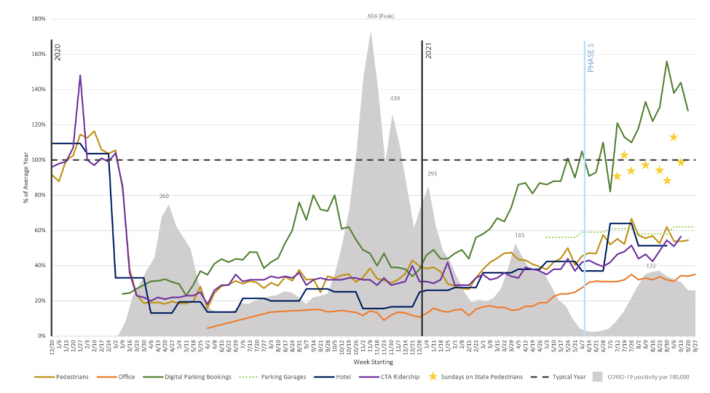Since the early days of the COVID-19 pandemic, the Chicago Loop Alliance has been issuing monthly recovery reports, tracking economic and physical activity trends downtown. And as long as Streetsblog has been following these reports, I’ve been a doomsaying Cassandra, bemoaning disproportionately-high-and-climbing parking volumes compared to pedestrian counts, CTA ridership, and other metrics which together followed a similar path of gradual improvement. Happily, the September report contains a bit of good news. Just don’t look too hard at the spikey green line, representing digital parking bookings, soaring above the other metrics.

The recovery reports measure hotel and office occupancy, CTA ridership, parking garage occupancy and digital parking bookings (for street-level parking) against 2019 levels, which CLA is using as a baseline “typical year.” Summer, along with warmer weather and a decrease of COVID-19 positivity rates – indicated by the gray background field on the chart – brought a rise of activity downtown with pedestrian counts, CTA ridership and hotel occupancy surpassing 50 percent of a typical year for the first time since March 2020. The trend happily continued into September, as the Delta surge abated and some offices began to return to partial in-person work. CTA ridership approached the 60 percent of normal mark by mid-September—by far the highest rate since the start of the pandemic.
The Loop Alliance’s Sundays on State open streets events, which ran for twelve weekends through the summer and early fall, drew visitors to the Loop as well. Pedestrian counts on these days are tracked separately on the report, marked by the gold stars clustered around the typical year dotted base line. CLA reasonably predicts that pedestrian and parking lines will continue the upward trend in October as theaters reopen. Let’s hope a good number of theatergoers opt to take public transportation – a convenient and way less pricey option than driving or ride-hail – downtown to catch a show.
Speaking of the digital parking line: It’s hard to call it anything but catastrophic. This metric peaked at a distressing 160 percent of “normal” the first week of September. The glimmer of hope is that the line dipped down steeply for the rest of the month, to about 125 percent of normal. The onset of cold and inclement weather never encourages folks to leave their cars at home, but hopefully extended and permanently adopted promotional fares on the CTA, Metra, and the South Shore Line will help incentivize more folks to return to transit and keep parking volumes dropping through the fall and into the winter.





